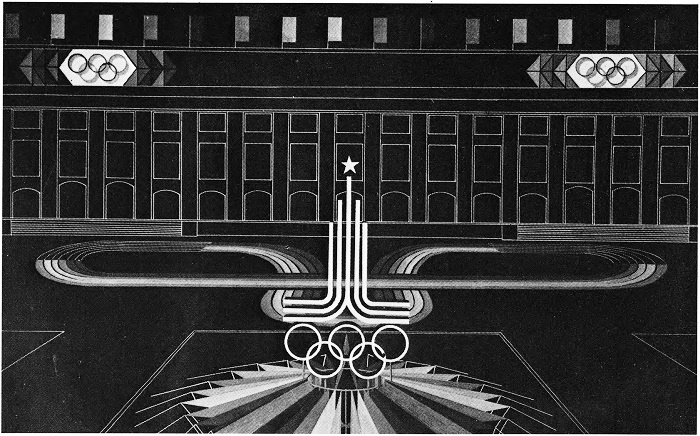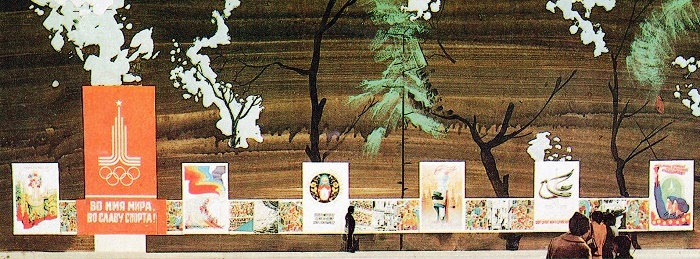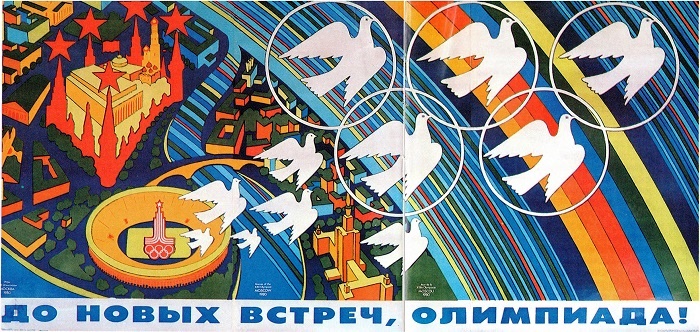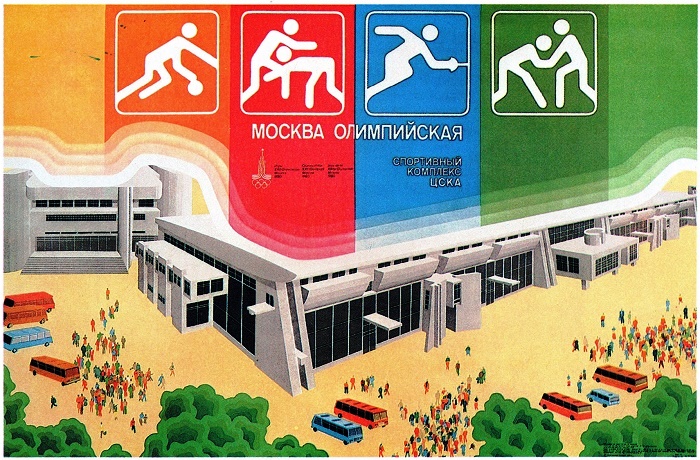Soviet Art for XXII Moscow Olympiad
Soviet Art for XXII Moscow Olympiad
Games of the XXII Olympiad, held in July-August 1980 in Moscow, have already become history. But in the memory of thousands of athletes participating in the competition, Muscovites and guests who have come to our country from many countries, hundreds of millions of TV viewers, they will forever remain a holiday of youth and health. Also, the clearest proof of how friendly and fruitful people can live and work together, cooperate and compete regardless of nationality and skin color.
The capital of the USSR was the first city of the socialist state in which the Olympic Games were held, the largest sports competitions of our time. Admittedly, they were a great success. Soviet art masters made an important contribution to the atmosphere of festivity and hospitality that distinguished the Games. Among them designers, monumentalists, graphic artists, painters, sculptors, poster and applied artists.

Detail. A. A. Leonova. Memorial medal of the Olympics-80 (reverse). Soviet Art for XXII Moscow Olympiad
The large creative team developed and implemented a diverse program for the design of the Games of the XXII Olympiad. In particular, the design of all sports facilities, administrative and auxiliary facilities and services, the creation of symbolic and emblematic, information and reference sign system. Besides, decorations for opening and closing ceremonies, awarding of winners, medals and diplomas, various uniforms, etc.
A variety of forms and techniques, examples of organic synthesis of fine art and architecture are ensembles of Luzhniki, the Olympic Village, and the Olimpiysky Complex on Mira Avenue.
A major part of the cultural program of the Olympics -80 were art exhibitions opened in Moscow these days, primarily the largest among them, the “Sports Ambassador of Peace”.
According to the International Olympic Committee, the world press, athletes, coaches and judges, guests, the Olympics-80 was held at a high organizational and technical level. And of course, in full compliance with the rules and regulations of the Olympic Charter. Such conditions, created for the participants of the Games in Moscow, were not at any of the previous Olympics.
After it became known that Moscow was chosen as the venue for the next Olympic Games, work began in the artist’s workshops. Masters of fine arts became frequent guests at stadiums and in sports halls, in sports palaces and on arenas. They watched training and competitions, met with athletes and their coaches, trying to look into the very essence of modern sports, to comprehend its basic laws to express it in new paintings and sculptures.
In fact, the organizational and creative activity of artists has developed in several directions.
First, it was necessary to develop and implement a broad program of artistic decoration of the Moscow Olympics – all of its facilities, administrative and auxiliary services. Accordingly, to create its symbols and emblematics, an information and explanatory system, invent opening, closing and awarding ceremony performances. For all this, it was necessary to find bright, intelligible decisions and highly artistic forms. The work was enormous.
For months, a large team of graphic designers developed a system of pictograms, symbolic signs of various sports and household services. Also, designed various information and advertising material: albums, posters, and booklets. In accordance with the traditions of the Olympics, special postage stamps and envelopes were prepared and issued.
Painters, sculptors, graphic artists, and arts and crafts specialists actively joined the preparation of the All-Union Art Exhibition.
It is difficult even to enumerate all the areas in which the masters of fine arts worked in those tense pre-Olympic days. And one publication is not enough to understand the contribution of Soviet Art for XXII Moscow Olympiad.
Soviet Art for XXII Moscow Olympiad

Variant of sports object decoration

V.V. Kershin. My main motto is Peace.1979. Poster

V. E. Pudakov. Universal sports hall in Izmailovo 1979. Poster

V. E. Pudakov. Moscow – the capital of the XXII Olympic Games 1980. 1978. Poster

Typical reference and information installation

Thematic exhibition on Mayakovsky Square

The project of a stand-alone volumetric space installation

The metro station ‘Sportivnaya’. Fragment of street decoration

The design of the building

Such quadrigs opened the Olympics in Ancient Greece

Sport object. Project

Showcase, the Polytechnic Museum

Showcase at the Polytechnic Museum

S.A. Artemov. Moscow. Games of the XXII Olympiad 1978. Poster

Projects of thematic exhibitions

Posters at the thematic exhibition

Panel near the Olympic village

Panel for the cultural center of the Olympic Village 1978-1979. Fragment. Artist V.K. Zamkov

One of variants of decoration

Octyabrsky Square, Thematic exhibition

Misha – the official mascot of the Olympics-80, closing ceremony

Live mosaic at one of the stands of the Grand Sports Arena in Luzhniki

Leninsky Prospekt, thematic exhibition

K. A. Rudov. Welcome. 1979. Poster

Highway decoration

exhibition on Lermontov Square

Entrance to VDNKh

Detail. A. V. Chantsev, M. N. Shestopal Moscow. Olympiad-1980 1980. The poster

Decoration of the Leningradsky Prospect

Closing ceremony

BI Dyuzhev. Sculpture ‘Olympic flame’. Izmailovo. 1979-1980

A.V. Arkhipenko Sport – ambassador of peace 1980. Poster

A. V. Chantsev, M. N. Shestopal. Until next time, the Olympics. 1979. Poster

A. V. Chantsev, M. N. Shestopal Sports Complex of CSKA 1979. Poster

A. V. Chantsev, M. N. Shestopal Sports Complex Dynamo. 1979. Poster

A. V. Chantsev, M. N. Shestopal Moscow. Olympiad-1980 1980. The poster

A. P. Boykov. ‘Welcome’. 1979. Poster

A separately standing three-dimensional installation

A separate volumetric space installation at the Olympic Village

Yachting

V.Yu. Scherbinin. Motorcycle racer 1973 oil on canvas

V.V. Arsentiev. Official emblem of the Games of the XXII Olympiad

A. A. Leonova. Commemorative medal of the Olympics-80 (obverse)

A. A. Leonova. Memorial medal of the Olympics-80 (reverse)

A.V. Volkov Bicycle race 1971. Watercolor paper

AP Klyavinsh. Basketball 1971. Oil on canvas

Archery

AV Saikin. Young Musketeers 1976. Paper, watercolor

B. A. Talberg. Panel ‘Hospitality’ for the cultural center of the Olympic village. 1979

Contour (skeletal) image of pictograms

Decoration of streets

Decorative banner with the emblem of the Olympics-80

Equestrian sports

Exhibition ‘Sport – Ambassador of the Peace’. Interior section of applied art

Football

Fragment. V. K. Zamkov. Panel for the cultural center of the Olympic Village 1978-1979

G. K. Liepin. Jockeys 1976. Oil on canvas

Graphic principles of the emblem of the Olympics-80

I.A. Postol. Award medal of the Olympics-80 (gold, both sides)

Information signs for sports facilities

Key rings and badges fir the Olympics-80

LM Sharov Olympic stamps. Series ‘Tourism on the Golden Ring’

Lutte Wrestling

Map of Moscow. Olympic facilities and tracks

Memorable Olympics-80 badges

NK Litvinov, Stamps

NK Litvinov. stamps

Official color spectrum of the Olympics-80

P. P. Postazh. Hand ball 1971. Oil on canvas

pennants

Pictograms of sports

Project for the design of the sports facility Fragment

Publications for the Olympics-80

The Olympics-80 badges

Typical design projects

V. A. Chizhikov. Poster with the official mascot of the Olympics-80

V. K. Zamkov. Panel for the cultural center of the Olympic Village 1978-1979. Fragment

V. T. Ni. Football players 1971. Oil on canvas
Source – Illustrated album “Artist and Olympic Moscow”. “Soviet artist”. 1984






